Note: this is not an advertisement or a sponsored post. Just a librarian’s honest opinion on a wonderful product.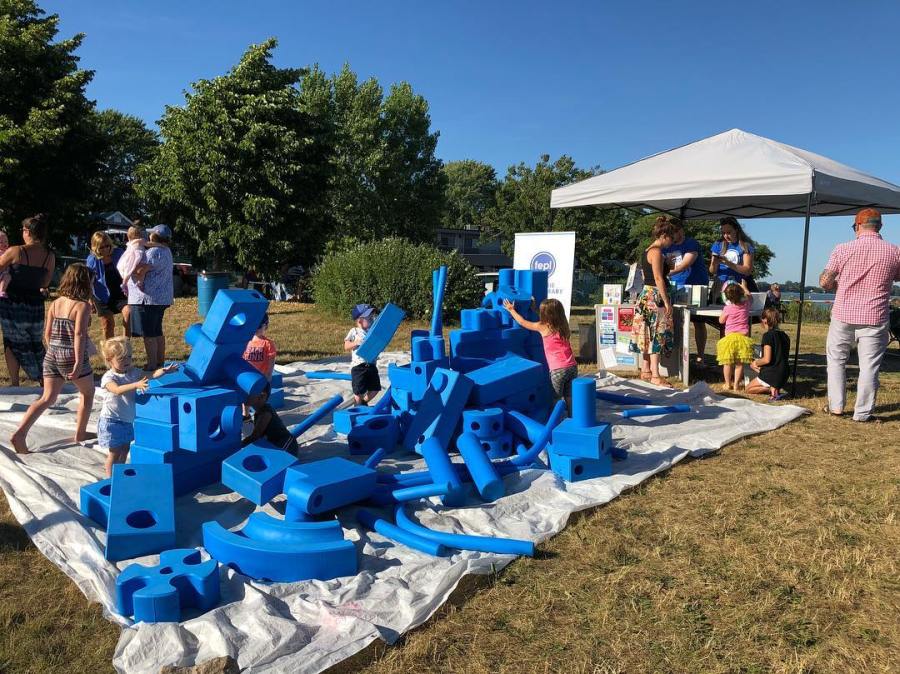
When I first heard of Big Blue Blocks, I knew that I wanted to bring them to my library. Not only do they encourage imaginative play and physical literacy, but they are durable, lightweight, and surprisingly stylish. Kids are drawn to them. They are the epitome of “big body play.”
Big Blue Blocks by Imagination Playground are light-weight large foam building blocks that appeal to a wide range of ages. I’ve seen toddlers, school aged kids, and teenagers using them at the same time – equally as excited. They come in three sizes, and I purchased the Large set. They provide the opportunity to develop crucial skills such as: pretending, construction, social, negotiation, lifting, spacial, etc.
My library received a grant called “Power Off and Play” that had to be used on a project to enhance physical literacy, and to encourage kids to replace screen time with healthy alternatives. It was the perfect fit for Big Blue Blocks. I used the blocks in three main ways: Big Blue Building Parties (in the library), Feature at Outreach Events, and for Activities at Large Events In the Library.
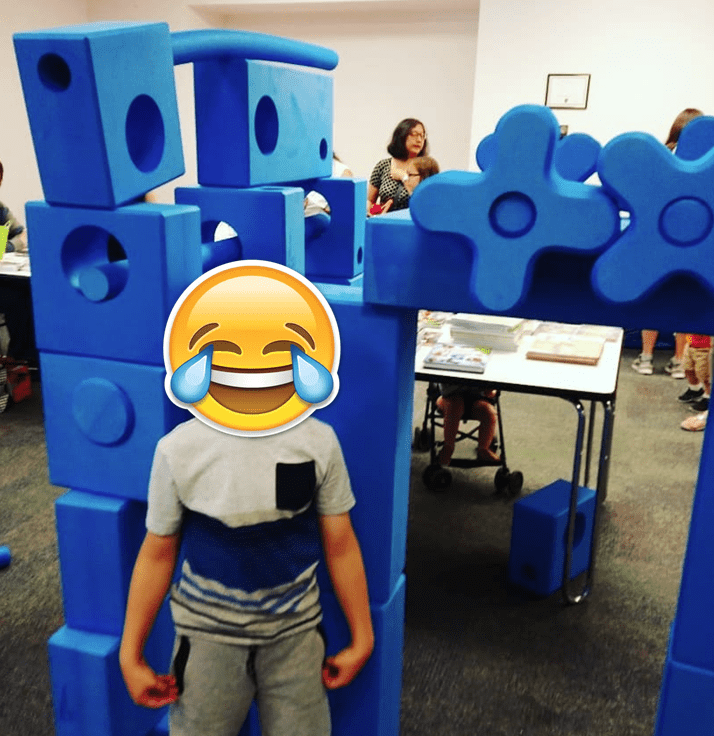
Big Blue Building Parties
Easy, peasy. I would put out all the blocks, play fun music, and let kids PLAY for one hour! The bigger the room, the better. For the most part, I did not need to do much more than show excitement for kids’ creations. From time to time I would suggest new building prompts – let’s make a submarine and go on a trip! Let’s build a castle, who wants to be the dragon? Let’s build a dance floor and a DJ booth!
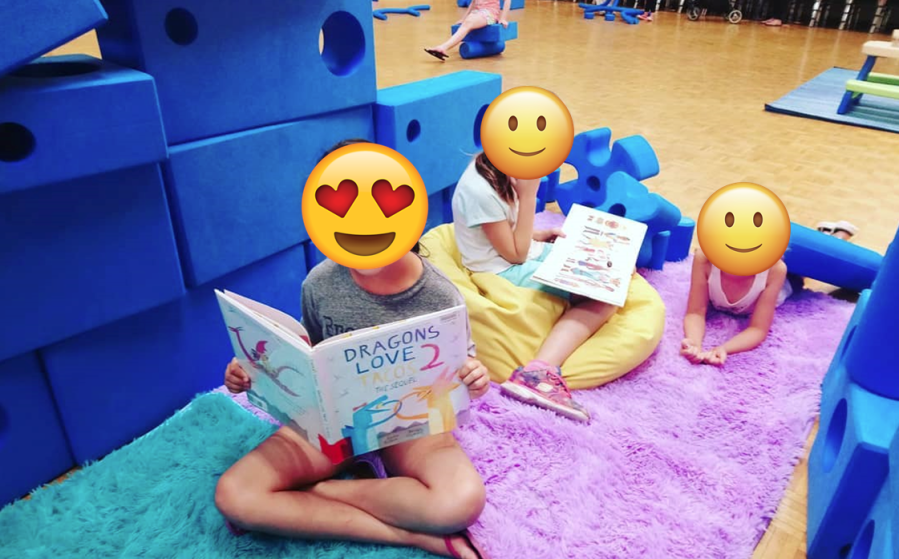
One time a group of kids worked really hard on a cozy reading fort, complete with a ball drop pathway running along the top of the wall. They they got all cozy inside and read picture books to each other. How wholesome is that?!
I ran these Big Blue Building Parties on a regular monthly basis, and they became great social opportunities for the regular families. Sometimes to enhance things a bit I would set aside a corner for baby toys – often toddler attendees had baby siblings who tagged along.
Outreach Events
This is the most challenging, yet most effective way I used the blocks. We had a great outreach presence in the community, and the blocks quickly became an important part of that. We brought them to large community events that would attract 1000+ attendees (Fall Fest, Supper Market, Food Festivals, etc). The blocks would be laid out on a tarp on the ground – ideally grass to soften potential falls. Near the blocks we’d have a table (with Summer Reading activities, book displays, and remote checkout), a tent, and a branded sign.
Kids came running. As soon as they saw the blocks, nothing else mattered – all they wanted to do was build! The blocks appealed to all ages, but at these events especially 3 – 6 year olds. Some kids wanted to spend all their time with the blocks, and parents had to pull them away!
Because of the large number of attendees at these events, crowd control was an important skill. Kids arguing over blocks was common, and I recommend intervening by gathering everyone towards a common goal like building a huge tower or castle. You need at least 2 staff members to run this event safely, but ideally you would have 4. We often invited volunteers to help us at these events.
When provided access to huge foam blocks, it only takes a little while before a kid builds a sword (or Thor’s hammer) and starts roleplaying violence. You might hear an excited cry of, “SWORD FIGHT” and turn to see two 6 year olds fencing. There has been some discussion in the children’s librarian world lately about Violent Fantasy Roleplaying (notably in The Cardigan Newsletter, which references this article on Play Fighting), and there’s a lot to consider. I don’t think the potential for play fighting should stop anyone from using the blocks – since almost everything we do has the potential for play fighting. It’s a developmentally appropriate behavior, and as long as no one is in danger and everyone is having fun, librarians can use their discretion. Maybe a parent will step in and stop it, or maybe a parent will grab a sword and join in.
Activities at Large Events in the Library
Fort Nite Challenge
What you need:
- One set of Large Big Blue Blocks
- 25 or more hollow plastic balls (think ball pits from McDonalds in the 90s)
I ran weekly events called Tween Club, and one week it was Fort Nite themed. I divided the large programming room in half: gamers played on the big screen on one side, and groups of 10 played the Blue Blocks Fort Nite Challenge on the other side. Each round of the challenge took 5 minutes, and we swapped teams in and out.
I ran a strip of tape down the middle of the room, and dumped all the blocks in the centre. They broke into teams, 5 vs 5, and then had 2 minutes to build a fort. After that, they had 3 minutes to throw as many plastic balls into the other team’s fort as they could. Each team had to remain on their side of the room at all times. At the end we counted how many balls were in each fort, and whoever had the least won. It was kind of like a more creative version of dodge ball.
This was a great challenge because they had to work together to build the work, and they had to strategize during the throwing part. Because of the time restraint, excitement levels were high and everyone was feeling very competitive.
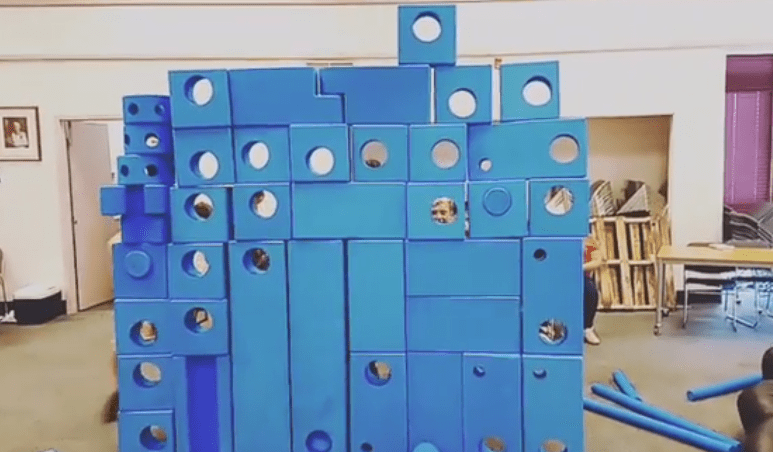
Tower Challenge
During large events like Summer Reading Launch Parties or in-library festivals, I would have a section with the blocks, and challenge kids to form teams and build the tallest tower. Through trial and error they would learn better strategies – which blocks can lock together to form a strong base, which blocks were lightest and could stay on top, etc. This was a fun and easy activity that could easily be done with only half the blocks.
Storytimes
From time to time I would bring the blocks out during a toddler storytime – usually when I knew we would have 45 or more attendees. It replaced regular toy time, and challenged the toddlers to share and build.
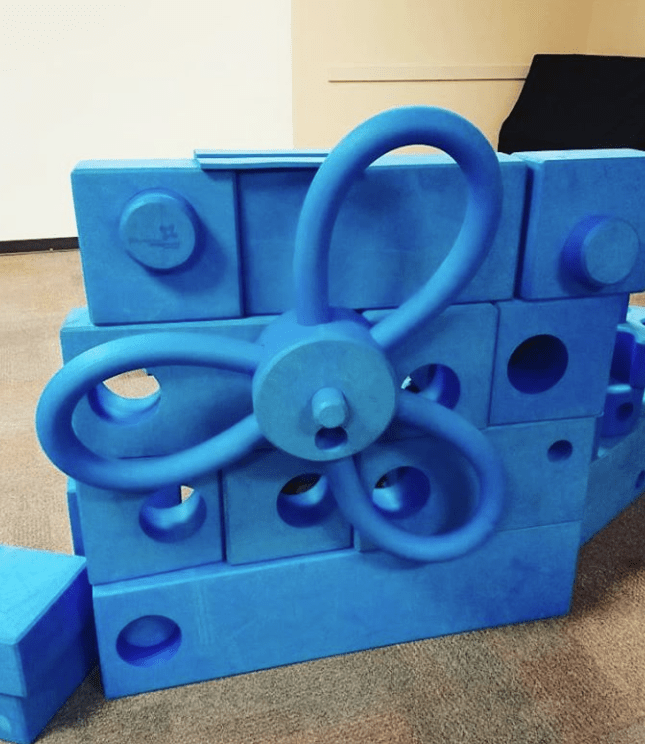
Other Ideas
Something I dreamed of was to have a section of the library for the Blocks to be out at all times. A large part of the children’s section of the library could be converted into a play space with soft flooring and a glass wall separating it from the other parts of the library. This of course, would be quite costly (glass walls are expensive!), and requires a lot of space that most libraries don’t have. If I was designing a new children’s library from scratch, I would prioritize an area like this, and I have no doubt that it would be used constantly by the community.
Another idea is to allow patrons to add the Big Blue Blocks to a room rental. I had patrons asking me how much it would cost to borrow the blocks for a birthday party. This could be an opportunity to generate revenue while offering a birthday party package that is cheaper/more accessible than most other options.
Storage of the blocks is a challenge. So is toting them around. I used extra large, clear plastic garbage bags to store and move the blocks, instead of purchasing bins. In the bags, most of the blocks could fit into 2 cars. I was able to store them in the basement of one of the branches, but if you don’t have a large storage area available, you’ll need to find one.

All in all – Big Blue Blocks were an incredible addition to my library! I hope this post helped answer any questions you might have about using Big Blue Blocks. If you’re considering it, and have grant money to spend, take the leap! Your community will thank you for it.





Can I ask how much your set of Big Blue Blocks cost? Their website just offers a “Contact Us” link, which usually makes me nervous about the price. The blocks look fabulous though!
Hi Beth,
For sure. I don’t remember the exact price, and I dont want to guess too closely in case their prices have changed, but the set I bought was over $4,000 and under $9,000. We got it covered by a grant, which was crucial for the small organization I was working at. Hope that helps!
[…] Most public libraries learned to embrace Fortnite in some way before the pandemic started. Many were running regular Fortnite Tournaments in their computer labs, or having gaming afternoons. Some of us created real-life versions of Fortnite (like the fort activity I outlined in Using Big Blue Blocks at the Library) […]